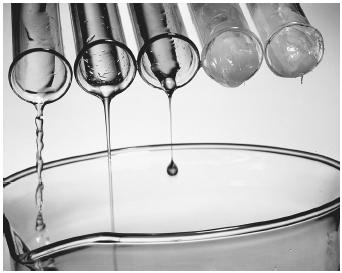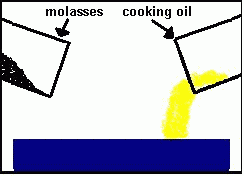The property that describes a liquid’s thickness or thinness is called viscosity; high viscosity (thick) liquids differ from low-viscosity (thin) ones. You will also use the particle theory to explain some behaviors and properties of fluids—liquids and gases. A fluid is any substance that flows. The particle theory can explain why some substances flow while others do not.
How Fast Do Fluids Flow?
Some liquids can flow faster than others. Orange juice flows freely from a jug or a carton, but how would you describe the flow of chocolate syrup from a bottle or the flow of honey from a jar?
Which one do you think would flow to the end of a pan first? If you wanted to know how fast you could run, you might ask a friend to time how long it would take you to run, say, 100 m.
This measurement would be your speed. In a similar way, you could measure how fast a fluid “runs”. You would measure the time it takes for the fluid to flow from one point to another (its distance). This characteristic is called the fluid’s flow rate.
Just as certain variables can slow you down in a race, certain variables can also slow down the flow of fluids. What property of fluids do you think might cause a liquid to slow down?
Applications of Viscosity in Liquids
Why might it be important to know how to determine the flow rate and, therefore, the viscosity of a liquid? The viscosity of liquids is an important property that must be measured precisely in some industries. For example, the viscosity of paints, varnishes, and similar household products is closely regulated so that the paints and varnishes can be applied smoothly and evenly with a brush roller.
In fact, antique dealers and many householders are glad that furniture stripping liquid has finally been thickened. In the past, this thin, smelly liquid was difficult to use because it tended to run down and off the furniture before it had a chance to remove old paint and finishes. Now, however, the viscosity has been increased to produce an almost gel-like texture, so that the product is easier to apply and sticks well to the surface of the furniture.
The viscosity of some medications, such as the various liquids used to remove warts, has also been modified for easier application. Drug companies manufacture medicines, such as cough syrup, that have a high viscosity yet are still drinkable, in order to coat and soothe the throat. People in many occupations need to know how to adjust the viscosity of a substance to suit specific applications. For example, chefs need to know how to make gravies thinner than sauces and frostings thicker than icings. Mechanics must choose an engine oil that is the right viscosity for the season.
Artists need to know how to thin or thicken oil paints or acrylics. Technicians must control the viscosity of various chemicals in chemical processing plants.
Now think about chocolate for a minute. The coating on candy bars must be at precisely the right consistency and temperature in order to cover the bar completely with the same amount of chocolate each time. Some candy coatings are especially sensitive to temperature. If the cany were to stay too hot for too long, it might become so hard that it would be unpleasant to bite. The candy would then have to be remade.
Canada’s maple syrup industry depends on controlling the viscosity of a liquid. Maple syrup comes from the sap of sugar maple trees. The sap itself is thin, runny, and not sweet to the taste. However, when the sap is heated and most of the water has evaporated, the result is a thick, sweet, and flavourful syrup, irresistible on pancakes and waffles!
Why Viscosity Varies
What if a small group of friends is trying to move through a large crowd of people at the mall. Would it be easier to sneak through the crowd if they were a group of grade 3 students or full-grown adults?
Well, assuming that the grade 3’s are smaller and take up less space than the adults, it should (theoretically) be easier for the kids to get through because they can more easily fit into any empty spaces within the crowd.
In a similar way, the particle theory suggests that small particles move past each other more easily than large particles can. Large particles take up more space.
But now imagine that everyone at that mall (including the kids) is carrying around huge parcels, bags, or knapsacks, etc. How would that affect their ability to navigate through a large crowd? Obviously, it would be more difficult because everyone’s “bulkiness” would be taking up more space. In the same way, some particles are bulkier than others because of their shape. For example, oil particles are bulkier than water particles. Thus, oil is more viscous than water.
Finally, imagine that everyone in the shopping mall is moving very, VERY slowly and will not move out of the way as the kids are trying to pass. In this situation, it would take an even longer time to move through the crowd. This is similar to what happens to particles when they are cooled—they slow down.
Even though all fluids flow smoothly, they flow at different rates because they have different viscosities. Another way to define viscosity is resistance to flow. Resistance to flow means that the particles can move around, but it may be difficult for them to pass by each other; this resistance generates internal friction. Another word for friction is “rubbing”. It is easier to skate on ice than on pavement because the friction between the skates and the ice is less than the friction between skates and pavement.
Similarly, it is easier for some fluid particles to move past each other, compared to other ones. Water particles slip past each other easily, but particles of honey have more internal friction and thus do not flow as easily. If fluids are relatively large or bulky, these particles take a longer time to pass each other, and thus the fluid’s flow rate decreases.
A liquid’s ability to flow also depends on the energy that the particles have to move around. The warmer the liquid becomes, the more energy the particles have to move out of the way and make room for other particles to pass. However, as the temperature drops, the particles have less energy to move around, so the empty spaces between them get smaller and smaller. In general, a fluid’s viscosity decreases as the fluid is heated and increases as the fluid are cooled.
What Factors Affect the Viscosity of Gases?
Although gases, in general, flow much more easily than liquids, the viscosity of gases can vary too. The size and shape (or bulkiness) of gas particles and temperature are factors that affect the viscosity of gases as well as the viscosity of liquids. Just like liquid particles, as gas particles get larger and bulkier, their viscosity increases.
The effect of temperature on gas particles is different, however, from the effect on liquid particles. While an increase in temperature reduces viscosity in liquids, the opposite is true for gases. Why? Gas particles do not depend on an increase in energy (a rise in temperature) to move farther apart, as is the case for liquids.
The particle theory suggests that gas particles are already very far apart. Extra energy increases the internal friction of gas particles because the particles speed up and collide with each other more frequently. Cooler temperatures in gases keep internal friction (and therefore viscosity) low.



wait but how does the viscosity affect how the liquid flows??.. I am a slow learner
Very clear and superb explanation…
Thank you so much
yes very very nice and useful
It’s very nice and useful